Learning How to Cook Steak is so easy! In this post, I’ll share with you all my tips and tricks (plus things to avoid) for cooking mouthwatering Butter Basted Pan-Seared steaks with a perfectly caramelized outside and a juicy, buttery, tender inside.
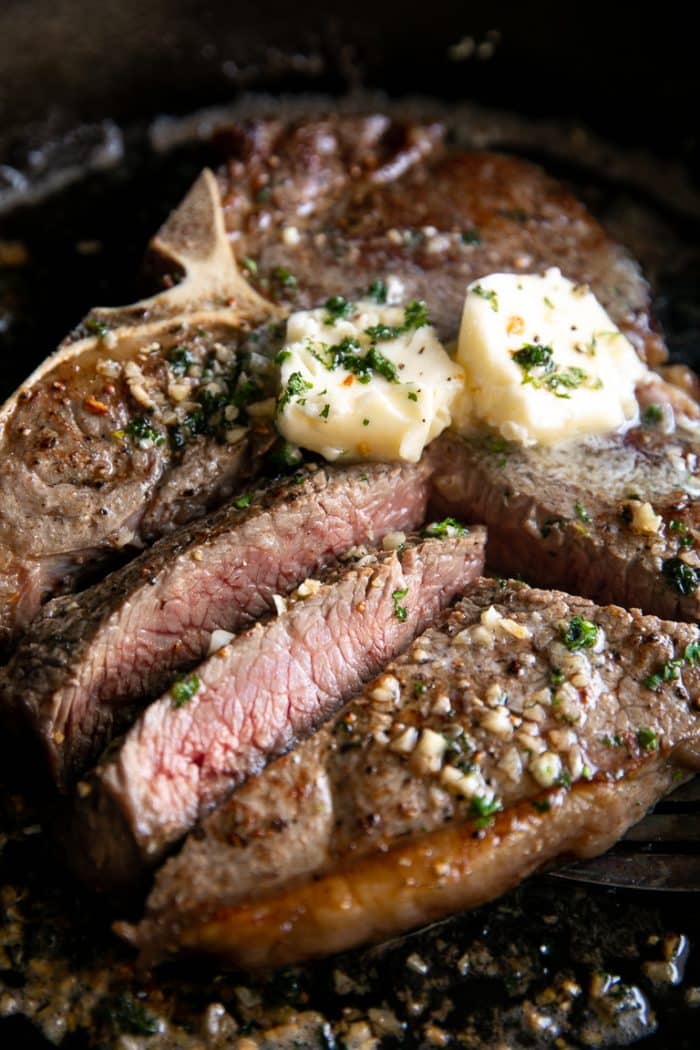
STEAK
Ok, you guys. Who’s ready to learn SO much about steak!? Lately, thanks to several requests from you guys, I have been working to add more steak recipes to this blog. Recipes including the instant fan-favorite Garlic Butter Steak Bites and Easy Steak Chili.
Today I’m going to talk about how to Butter Bast and Pan-Sear Steak, but don’t worry. You’re going to learn all kinds of other helpful tips and tricks that will make cooking your next steak easy breezy!
If you’re new to cooking steak and feel super intimidated, I totally felt…err, feel…ya. I avoided cooking steak for YEARS because I was positive that I would ruin my beautiful twenty dollar piece of meat. You guys, if I can do it, you can do it too! PROMISE!
And, if you’re sitting there wondering what in the world “butter basted steak” is, don’t worry about that either. I’m going to walk you through it.
Ok, let’s get started.
TOOLS NEEDED TO COOK THE BEST STEAK EVER
I don’t normally put this at the top of a post, but in today’s case, it’s extra important. In fact, it is so important I am going to write it in all capital letters. I am not shouting at you, but I (definitely) will if you don’t follow this one very simple rule.
YOU MUST USE A DIGITAL MEAT THERMOMETER!
Here’s why. Gone are the days of slicing into our steak midway through cooking just to see if it’s done. No more of that, my friends. We have the technology to help us be better cooks and the digital meat thermometer is probably my number one must-have for the kitchen.
So, now that you know how I really feel the only other thing I recommend is a good skillet and Kitchen Tongs. I know what you’re thinking, “what’s a good skillet?”
I actually don’t have an exact answer for this other than-
- If you use a pan that you absolutely love to cook with, use it. Just make sure it’s big enough to fit the entire steak comfortably and it’s sturdy. I have a couple of skillets like this, my cast iron skillet and my stainless steel skillet (each which you have probably seen in a million pictures on this blog).
- If you don’t have a favorite or you’re up for trying something new then I would go with cast iron. Actually, I really really recommend cast iron, but I don’t think it’s a MUST HAVE (just a HIGHLY recommended).
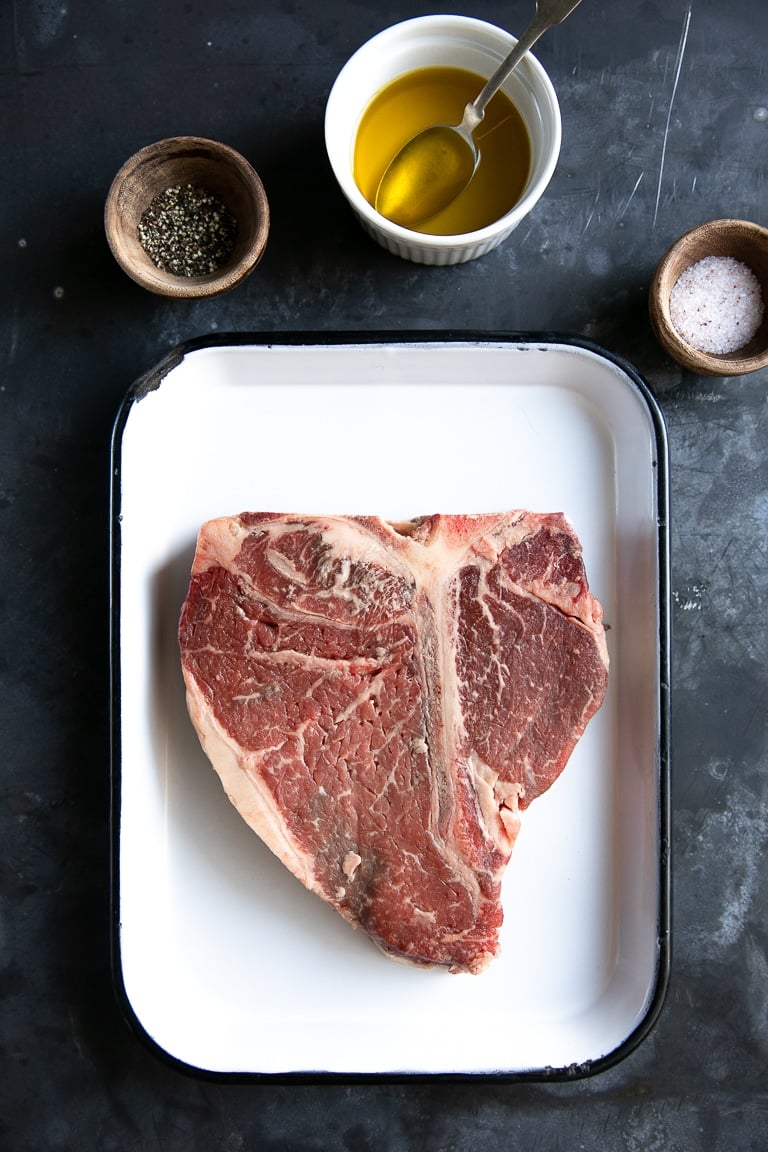
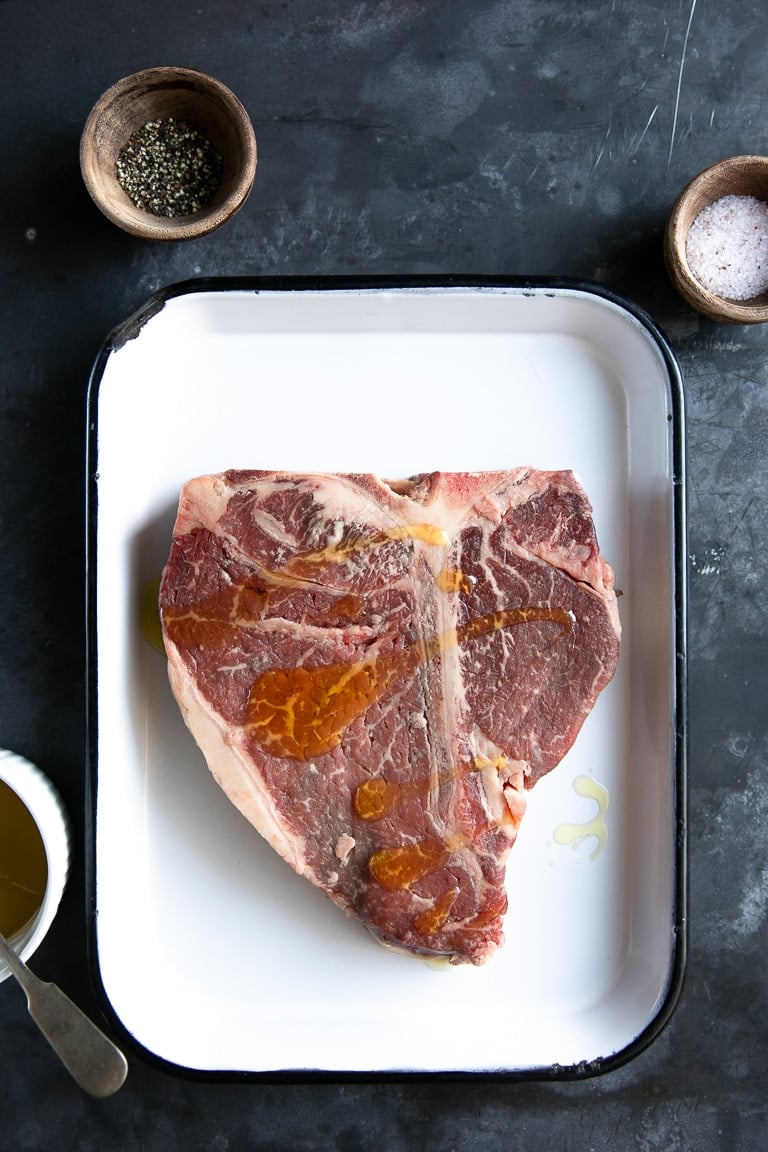
DIFFERENT CUTS OF STEAK
I’m not going to go into every single different cut of steak you can purchase because that deserves its very own special post. However, I am going to give you an overview of some of the most popular.
1 | TENDERLOIN
- Also known as filet mignon, Châteaubriand, fillet, or filet, it is the most expensive cut of steak you can buy, so this is one piece of meat you really don’t want to mess up when cooking at home.
- The tenderloin cut is always sold boneless and comes from the short loin and sirloin, under the ribs. Depending on which part of the tenderloin the steak is cut from determines its name- the filet mignon is from the smaller end while the Châteaubriand is from the thicker end.
- Super lean, lower in fat, and extra tender (hence the name), the tenderloin is often a cut extra thick.
2 | NEW YORK STRIP
- Also goes by the names strip, Manhattan, Kansas City strip, top sirloin, top loin, contre-filet.
- Usually sold boneless, the New York Strip is the short loin just behind the ribs. With fat on one end of the steak and some marbling scattered throughout, this cut has more overall fat compared to the Tenderloin.
- This means that the New York Strip is a happy middle-of-the-road cut of steak that is neither too fatty or too lean.
3 | PORTERHOUSE
- Aka T-Bone (also what’s shown in this post)
- Fun fact– According to USDA regulations, in order to be classified as a porterhouse, the tenderloin portion of the steak must be 1.25″ wide, while only .5″ wide to be classified as a T-bone.
- Served bone-in, with the bone looking like a “T” and having meat on both sides. On one side is a piece of the Tenderloin and on the other is a piece of the New York Strip.
- Cooking the Porterhouse (or T-Bone) can sometimes be tricky as you are essentially cooking two different cuts of meat at the same time. Don’t worry, I have a solution for that (although some would say to never cook a Porterhouse in a cast iron skillet).
4 | RIBEYE
- May also go by (though I’ve never heard of) Entrecôte, Delmonico, Scotch fillet, Spencer, market, beauty.
- Sold boneless or bone-in, the Ribeye is from the upper ribcage and are basically individual cuts of prime rib.
- With lots of fat and marbling, this cut of steak is extra juicy and flavorful and loves being cooked over high heat.
5 | FLANK STEAK
- Also known as the London Broil (and what my dad always cooked for us when we were growing up)
- Known for being super lean, flank steak love to be marinated and grilled or thinly sliced and added to stir fry.
- I wouldn’t recommend the Flank Steak for the method I describe in this post.
WHAT IS THE BEST CUT OF STEAK FOR PAN-SEARING?
As you can see, I cooked a Porterhouse (aka T-bone) in my cast iron skillet. The results were amazing (despite warnings not to cook a T-Bone in a hot skillet). If this is your first time, give the Porterhouse a try or play it safe and go with the Ribeye. That said, any of the following would work great! Just remember to use your digital thermometer and read the following instructions thoroughly.
- Ribeye. Safest choice.
- Porterhouse (T-bone). Best of both worlds.
- New York Steak. Economical.
- Tenderloin. Best cut, but super sensitive.
HOW TO PICK THE BEST STEAK?
Have you ever wondered what the different grades for steak mean? I mean, I’ve seen them, but I’ve never really understood them. So I usually just pick up whatever looks good.
Turns out, those grades actually mean something! And may actually help guide your decision when picking out your next steak dinner.
What determines the grade of the meat?
Two main things determine its grade- the age of the animal and the marbling of the cut. There are three different consumer grades for beef.
- Prime Grade Beef– making up only 2% of all the beef produced in the US, Prime Grade is almost always sold to restaurants and hotels. Produced from young, well-fed beef, it has abundant marbling and therefore, superior flavor.
- Choice Grade Beef– Somewhere in the middle between Prime and Select, Choice Grade is the best choice when shopping for steak. Still high quality, but with less marbling when compared to Prime.
- Select Grade Beef– Typically leaner, somewhat less tender, and less marbling overall. Select beef is ideal for marinating or braising.
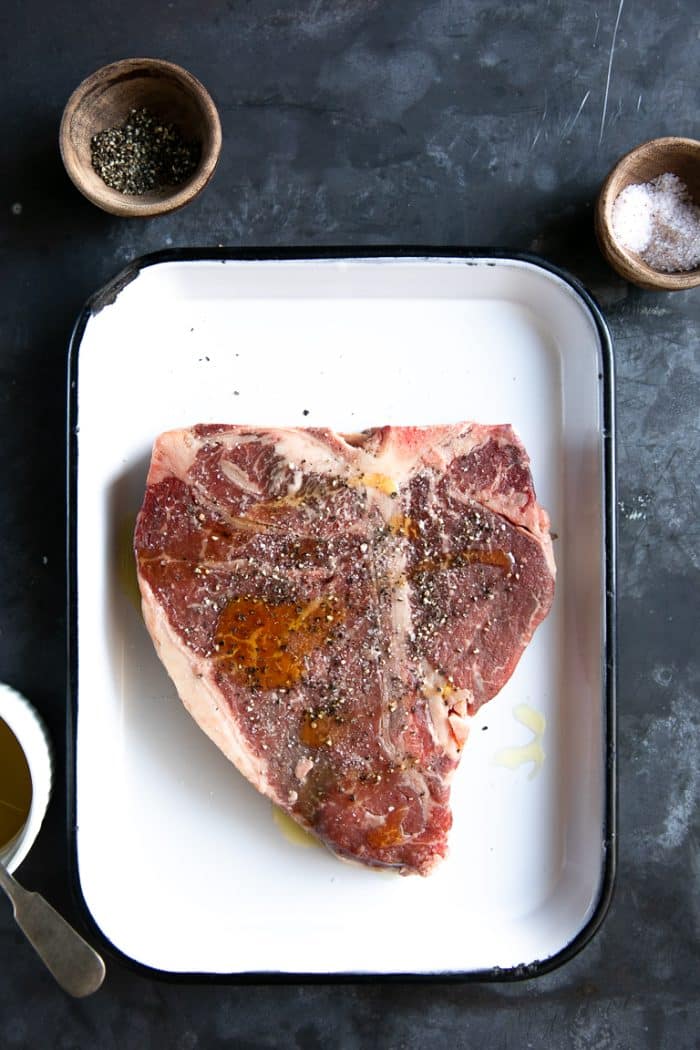
WHEN DO I KNOW MY STEAK IS FINISHED COOKING?
Your digital meat thermometer will tell you. I typically start checking after 4 minutes of cooking.
- Rare (120-130℉) – Just a minimal sear on the exterior of the meat.
- Medium Rare (130-135℉) – A true sear on the outside, yet still pink on the inside.
- Medium (135-145℉) – Not bloody, not dry, with some pink.
- Medium Well (145-155℉) – It’s been cooked. Teetering on drying it out.
- Well Done (155℉ and higher) – Totally browned, cooked through, and probably lost some of its juiciness.
INGREDIENTS IN THIS BUTTER BASTED PAN-SEARED STEAK RECIPE
The list is small so make sure that, whatever you buy, it’s the good stuff. At least, that’s my advice for the best results possible.
- Steak – The cut and grade is up to you. However, as I mentioned above, this method works best for Ribeye, Porterhouse, or New York Strip. Ideally, you want a steak that is AT LEAST 1.5-INCHES THICK with lots of nice marbling.
- Salt. Coarse kosher salt is recommended. It is also recommended that you pleaseseason your steak well and, time permitting, at least 30 minutes before cooking.
- Fresh ground black pepper. Same as the salt, season well. Remember, you’re seasoning a steak that is (or should be) at least 1.5-inches thick.
- Oil. Let’s chat about the oil real quick. I used two types of oil for this steak. Olive oil for rubbing and canola oil for cooking. I don’t recommend adding olive oil to your skillet because, well, your skillet is going to be SUPER hot. You want to use an oil that can deal with the inferno coming its way. Olive oil, while tasty, has a lower smoking point, so I wouldn’t use that. Canola, vegetable, or something like avocado oil are all much better options.
- Butter. You guys, we are cooking this steak by continuously basting it with butter and oil throughout the cooking process! It’s actually pretty fun, so don’t get nervous. However, I do recommend using real unsalted butter.
- Garlic. Ok, so the garlic is optional. I add it at the end and it makes a sort of garlic butter. If you’re not feeling it, or you hate garlic, leave it out.
- Fresh Parsley. Also optional, but I like a little sprinkle on the top.
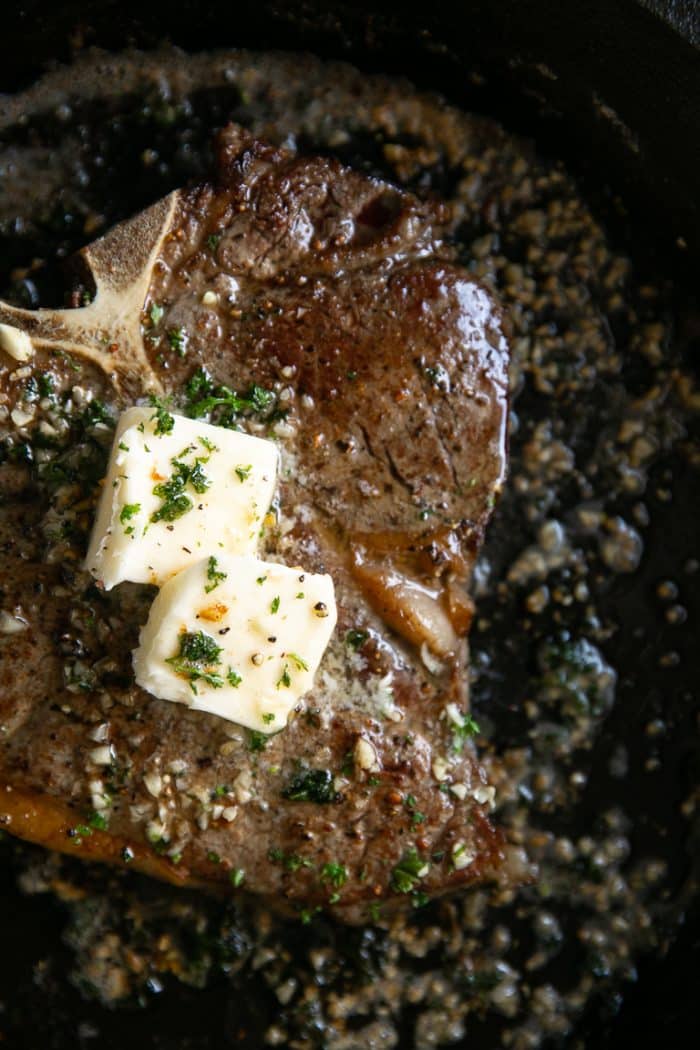
HOW TO COOK STEAK (THE BEST WAY!)
- First and foremost, remove your steaks from the refrigerator and pat them dry with paper towels. Once your steak is nice and dry, drizzle with olive oil (not too much- approximately 1-2 teaspoons for the whole steak) and sprinkle liberally with salt and pepper. Use your hands to rub the olive oil and seasoning all over the steak- sides, edges, etc.
- Allow your steak to rest and come to room temperature for at least 45-60 minutes. This is super important. You really don’t want to add a cold steak to a super hot skillet.
- Before cooking gather any additional ingredients and tools and get them ready. You’ll need oil, butter, minced garlic (if using), large skillet, a spoon, tongs, and your meat thermometer.
- When ready to cook, place a large heavy-bottomed skillet over high heat. Allow your skillet to get nice and hot for a minute or so before adding the oil. Allow the oil to get hot before adding the steak (but not so hot that you’re setting off the smoke detector). Very carefully add your steak to the skillet and allow it to cook for 1 minute undisturbed.
- After one minute use your tongs to carefully flip (yes! flip) your steak. Allow the other side to cook for 1 minute, undisturbed. Flip again.
- Now, assuming you are right-handed (if you are left handed, it will be the opposite), take the handle of your skillet in your left hand and tilt the pan just slightly. In your right hand use a spoon to collect and baste the top of the steak with hot oil. Baste everywhere, but focus more on the New York Strip side as that has a higher fat content. Continue for 1 minute then flip. Repeat this same process for 1 minute on the other side.
- By this point, your steak has been cooking for 4 minutes total (2 minutes on each side). Check the internal temperature of your steak with your digital meat thermometer.
- Add the butter to the skillet.
- Continue flipping (every 30-60 seconds) and basting with butter. After 1-2 minutes more, add the garlic and check the internal temperature of your steak again.
- Continue until the thickest part of the tenderloin side registers 120-125 degrees F (49-52 degrees C) for a medium-rare steak or 130 degrees F. (54 degrees C) for medium.
- Immediately transfer steak to a large plate and allow it to rest for at least 5 minutes before carving and serving.

TIPS AND TRICKS (AND THINGS TO AVOID) WHEN COOKING STEAK
I cooked several steaks while putting together this post because I wanted to make sure that it was so legit and so good that anyone could do it. In the process, I learned a few helpful tricks.
- Bring your steak to room temperature before adding it to the skillet. If you plan to spend good money on a delicious steak, it only makes sense that it be cooked properly from the start, right?
- Season your steak. You have a piece of meat that is 1.5 inches thick and you can only season the outside. You can be a little generous with the salt, ok? Kosher salt with coarse granules is my top pick.
- Use kitchen tongs to flip your steak. This is for two reasons- if you try to flip it with a fork, you may accidentally (but easily) drop it, which could actually hurt because hot oil splattering everywhere never feels good. And second, every single time you stab your steak you are releasing delicious juices. In other words, your hurting yourself and drying out your steak.
- Make sure your skillet is hot enough before you add the steak. This is SO important. Do NOT add your steak to a warm, or just a sorta kinda hot, skillet. You want a HOT skillet, you guys. This is why cast iron is recommended for this method.
- You want a medium-rare steak, but you don’t trust your instant digital read meat thermometer so you just give it one more minute. DON’T DO THIS. Basically, you guys went from medium-rare to medium and dry.
- You need to rest your steak. I know, we’re all hungry and we all want our food like right now, BUT, wait 5 minutes. It’s worth it.
- Don’t try to make this a diet recipe and cut out the added oil and butter. It just won’t work.
- Pick the right steak (see above) and one that is at least 1 1/2 inches thick.
WHAT TO SERVE WITH STEAK
Basically, everything goes with steak! This steak recipe is especially versatile since it wasn’t marinated in any sweet or overpowering sauces. And since this steak recipe is so amazing on its own, I recommend serving it with something that won’t take away from its awesomeness.
My top pics for vegetables include this easy 10-minute Bok Choy, Sautéed Brussels Sprouts, Roasted Carrots, Oven Roasted Cauliflower. Growing up my dad would always serve steak with buttered corn or broccoli and cheese sauce.
Other popular sides include Mashed Potatoes, Roasted Potatoes, or side salads like this Roasted Beet Salad or Tomato Salad.
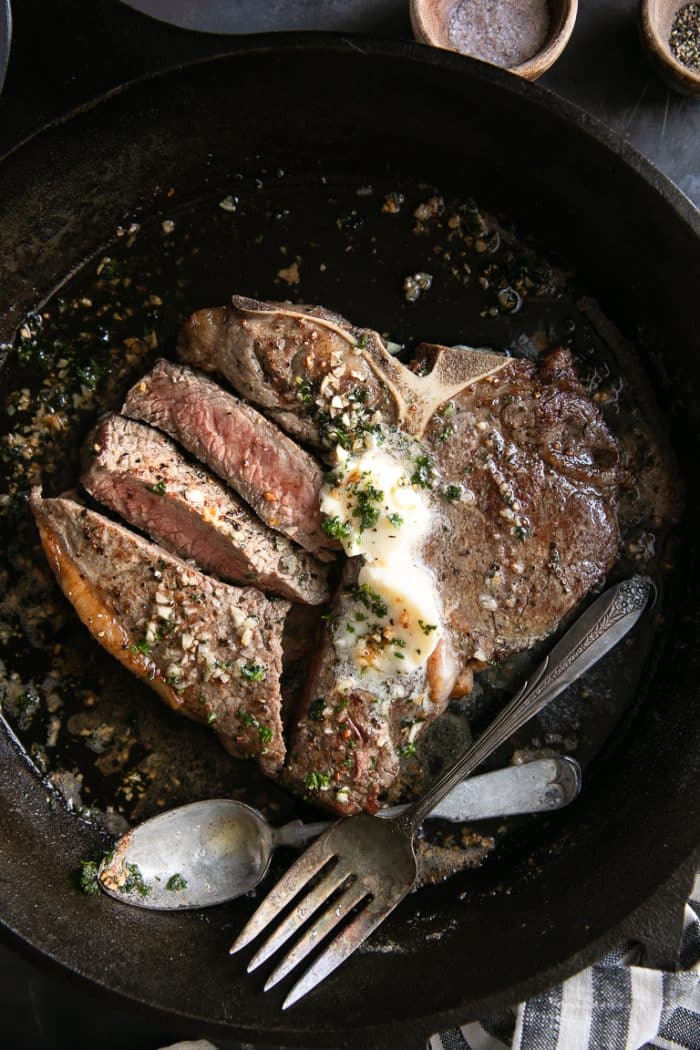
All credit for these delicious tips goes to The Forked Spoon. https://theforkedspoon.com/how-to-cook-steak/





